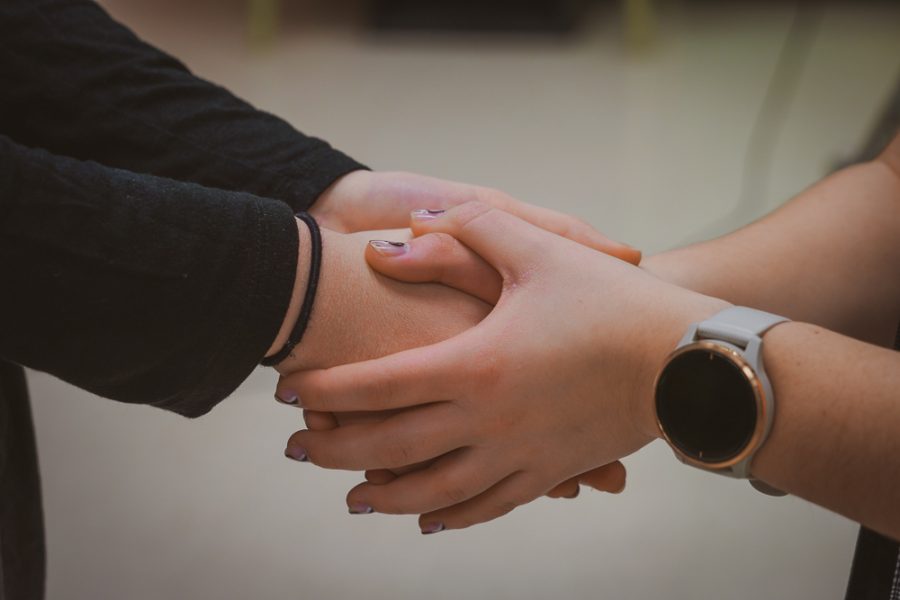Opinion: Back in Touch
Physical contact, vital to our mental health, was in short supply during the pandemic — but Americans’ aversion to touch existed long before COVID-19.
Physical touch is an important, but overlooked, component of relationships.
March 23, 2022
A handshake. A high five. A pat on the back. A head against a shoulder. A hug.
These are all simple, normal acts of physical touch that we don’t really give a second thought to. Touch is the simplest form of human communication, existing long before any language did. It can be used to express all sorts of things whether that be sympathy, sportsmanship, or love.
Though it seems nothing to dwell on, physical touch actually holds a very important part in our mental health. In fact, there is even a term for lacking in physical touch–touch starvation.
Of course, with the COVID-19 pandemic, we have all collectively gone through a period of touch starvation. In fact, my view on touch changed because of the pandemic.
Growing up, I was not a very touchy person. Sure, I would’ve liked a hug from a friend every once in a while, but I never felt the need to act upon it. However, the isolation that came with the COVID-19 pandemic completely changed my view on touch.
Not being able to physically be present with another human being takes a toll on mental health. As public life started to re-open, I realized it was ridiculous that I believed I couldn’t use physical touch as a way to show affection to the people I love in my life. If I’m happy to see a friend, I’m going to hug them. If a friend is tired, I’ll gladly lend my shoulder. If a friend is having a rough day, I’ll put an arm around them.
However, I’ve also come to see that touch starvation has existed long before the pandemic. In fact, it’s a cultural issue.
America, more than many other cultures, tends to view any sort of physical touch between people as either romantic or sexual in nature.
For example, I remember an instance where I was holding my friend’s hand when we were on a very steep and tall escalator as she was afraid of heights. A person approached and asked if we were a couple. Now, I wasn’t offended at the thought of being seen as a couple, but it frustrated me as to why a display of comfort to a friend was seen as romantic in nature.
This rings especially true for men, as it is generally seen as less acceptable for males to display affection toward one another, and when they do, they’re often called “gay.” We’ve all seen an awkward photo of two male friends posing together where they’re standing three feet apart with one arm reluctantly around the other’s shoulder, right?
Just as an example, in South Korea, where I spent the first seven years of my life, it’s common and accepted to see friends walking down the streets holding hands or linking arms without it being seen as romantic.
Author Anna Broadway, who observed the platonic touch between people during her travels to 40 countries, writes that “three different men in Tanzania held my hand, all in the context of crossing a busy street or otherwise helping ensure my safety.”
America’s collective view of physical touch as inherently romantic needs to change. By doing so, we are depriving ourselves of one of the most basic and important components to our mental and even physical health.
We are not always involved in romantic relationships, so if we save touch strictly for romantic relationships, we are going to be missing out on a lot of touch. Additionally, there is nothing wrong with showing your platonic or familial love for another through touch. Why do we form such deep emotional bonds with people but not allow ourselves to express that bond through something as simple as a hug?
“Human beings are wired to touch and be touched. When a child is born, that is how they bond with their mother—through touch,” said Asim Shah, M.D., Professor and Executive Vice Chair of the Menninger Department of Psychiatry at Baylor College of Medicine.
Though it may seem unlikely, touch actually has benefits for physical health. Touch stimulates pressure receptors beneath the skin, sending electrical signals to the vagus nerve, which regulates breathing, blood pressure, and heart rate.
But it’s more important to reiterate that touch has benefits for mental health, too. Affectionate touch releases serotonin.
“Serotonin is the body’s natural antidepressant and antipain chemical,” Director of the Touch Research Institute at the University of Miami Miller School of Medicine Tiffany Field said.
Even without exact science, it is easy to see how the lack of a physical manifestation of love and affection can lead to negative feelings.
Of course, people have different boundaries when it comes to physical touch. Some may not be comfortable with a hug from a friend, and others may not want any sort of touch at all unless from a romantic partner. Others’ boundaries should always be respected.
However, if you desire physical affection but feel that it goes beyond the norm, know that it is a perfectly normal and healthy thing to desire, show, and receive. Showing love should never be constricted by societal norms.
As psychiatrist and biobehavioral scientist at the University of California, Los Angeles Steve Cole puts it, “Touch is the most powerful safety signal of togetherness.”













